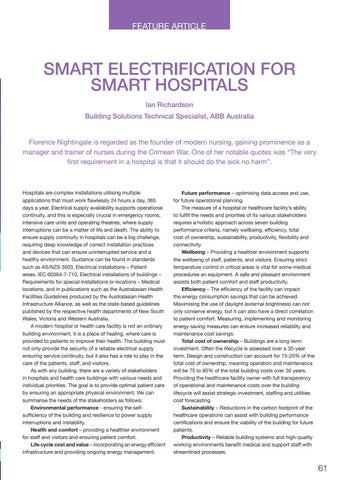FEATURE FEATUREARTICLES ARTICLE
SMART ELECTRIFICATION FOR SMART HOSPITALS Ian Richardson Building Solutions Technical Specialist, ABB Australia Florence Nightingale is regarded as the founder of modern nursing, gaining prominence as a manager and trainer of nurses during the Crimean War. One of her notable quotes was “The very first requirement in a hospital is that it should do the sick no harm”.
Hospitals are complex installations utilising multiple applications that must work flawlessly 24 hours a day, 365 days a year. Electrical supply availability supports operational continuity, and this is especially crucial in emergency rooms, intensive care units and operating theatres, where supply interruptions can be a matter of life and death. The ability to ensure supply continuity in hospitals can be a big challenge, requiring deep knowledge of correct installation practices and devices that can ensure uninterrupted service and a healthy environment. Guidance can be found in standards such as AS/NZS 3003, Electrical installations – Patient areas, IEC 60364-7-710, Electrical installations of buildings – Requirements for special installations or locations – Medical locations, and in publications such as the Australasian Health Facilities Guidelines produced by the Australasian Health Infrastructure Alliance, as well as the state-based guidelines published by the respective health departments of New South Wales, Victoria and Western Australia. A modern hospital or health care facility is not an ordinary building environment, it is a place of healing, where care is provided to patients to improve their health. The building must not only provide the security of a reliable electrical supply ensuring service continuity, but it also has a role to play in the care of the patients, staff, and visitors. As with any building, there are a variety of stakeholders in hospitals and health care buildings with various needs and individual priorities. The goal is to provide optimal patient care by ensuring an appropriate physical environment. We can summarise the needs of the stakeholders as follows: Environmental performance - ensuring the selfsufficiency of the building and resilience to power supply interruptions and instability. Health and comfort – providing a healthier environment for staff and visitors and ensuring patient comfort. Life cycle cost and value – incorporating an energy efficient infrastructure and providing ongoing energy management.
Future performance – optimising data access and use, for future operational planning. The measure of a hospital or healthcare facility’s ability to fulfill the needs and priorities of its various stakeholders requires a holistic approach across seven building performance criteria, namely wellbeing, efficiency, total cost of ownership, sustainability, productivity, flexibility and connectivity. Wellbeing – Providing a healthier environment supports the wellbeing of staff, patients, and visitors. Ensuring strict temperature control in critical areas is vital for some medical procedures an equipment. A safe and pleasant environment assists both patient comfort and staff productivity. Efficiency – The efficiency of the facility can impact the energy consumption savings that can be achieved. Maximising the use of daylight (external brightness) can not only conserve energy, but it can also have a direct correlation to patient comfort. Measuring, implementing and monitoring energy saving measures can ensure increased reliability and maintenance cost savings. Total cost of ownership – Buildings are a long-term investment. Often the lifecycle is assessed over a 30-year term. Design and construction can account for 15-25% of the total cost of ownership, meaning operation and maintenance will be 75 to 85% of the total building costs over 30 years. Providing the healthcare facility owner with full transparency of operational and maintenance costs over the building lifecycle will assist strategic investment, staffing and utilities cost forecasting. Sustainability – Reductions in the carbon footprint of the healthcare operations can assist with building performance certifications and ensure the viability of the building for future patients. Productivity – Reliable building systems and high-quality working environments benefit medical and support staff with streamlined processes.
61











